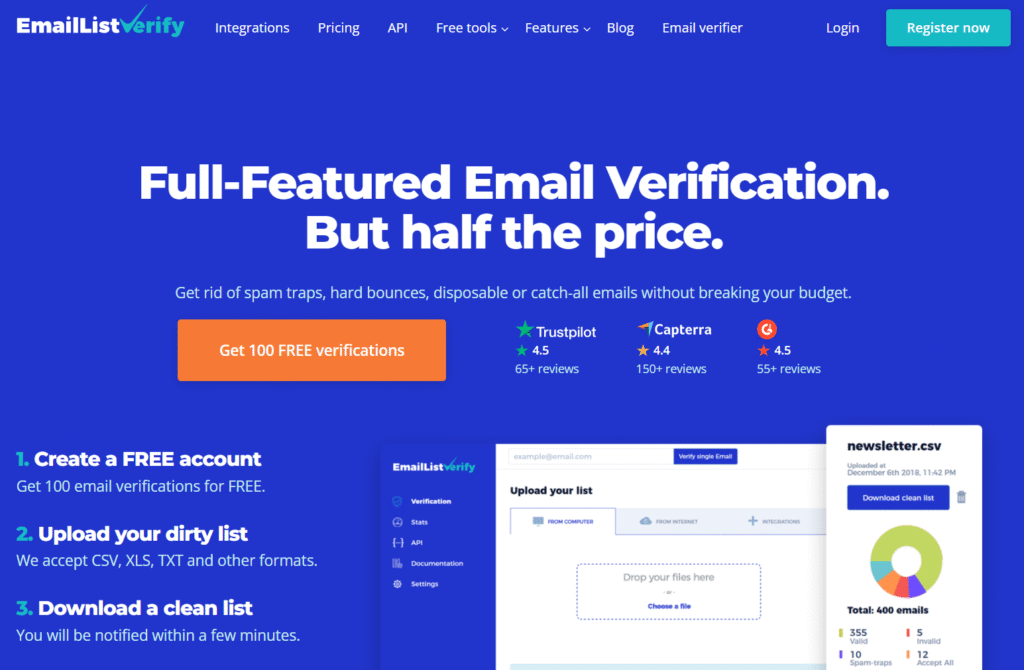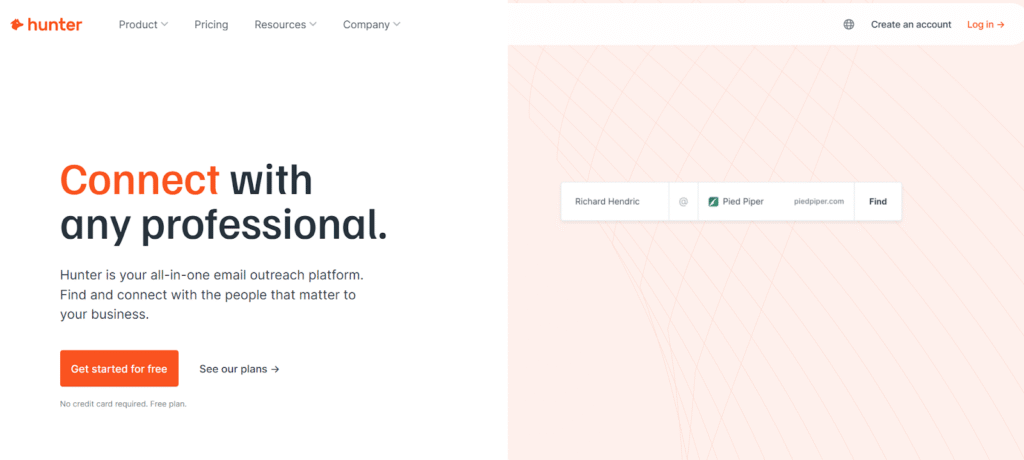Hard bounces drain sender reputation, distort campaign metrics, and waste budget. If your list includes stale sign-ups, typos, or addresses parked behind catch-all domains, you’ll feel it in lower inbox placement and throttled sending. The fix is choosing an email verification tool that fits your volume, workflow, and tech stack. Below is a quick, skimmable shortlist for 2026 with starting prices and where each option shines. The full guide that follows explains how verification works, how to test accuracy on your data, and what to look for in bulk and API use cases so you can keep lists clean and bounces down.
A Quick Overview of the Best Email Verifiers for 2026
Choosing the right email verification tool saves budget, lowers hard bounces, and steadies inbox placement. This piece gives you a quick shortlist for 2026, a plain-English explainer of how verification works, nine vendor reviews with pricing and feature tables, and a 7-point checklist you can run on your own data. You’ll also get pros/cons and clear answers to common questions so you can pick a tool, set pass/fail thresholds, and move from trial to production with confidence.
| Tool | Why it’s strong | Pricing (from) | Best for |
| Snov.io Email Verifier | All-in-one stack (finder, verifier, outreach) with credit sharing and 7-tier verification | $29.25/mo Starter suite; credits cover verification too | SMBs that want verification alongside prospecting and cold email |
| Bouncer | Clear pay-as-you-go tiers, doesn’t bill for duplicates/unknowns; solid real-time API | $8 / 1,000 credits (PAYG) | Teams cleaning lists in batches and via API |
| MillionVerifier | Aggressive high-volume pricing; EverClean automation option | $389 / 1,000,000 verifications (one-time) | Large senders needing low cost at scale |
| ZeroBounce | Flexible credits or subscription; deliverability add-ons | $18 / 2,000 credits entry point | Senders who want verification plus diagnostics |
| Clearout | Subscriptions and PAYG; real-time checks and wide integrations | $18/mo starter tier | Marketers needing steady monthly allotments |
| EmailListVerify | PAYG + monthly; API included; free 100 checks to try | Free 100 checks; paid plans available | Budget-focused list cleaning with simple setup |
| NeverBounce | Familiar UI and ESP integrations; popular PAYG model | $8 / 1,000 credits | Occasional cleans where PAYG is preferred |
| Hunter Email Verifier | Part of a broader data platform; auto-verify; generous team seats | £28/mo Starter | Sales teams already using Hunter’s finder/data |
| BriteVerify (Validity) | Enterprise-grade option within a larger suite; real-time capture | Contact sales / PAYG | Larger programs standardizing on Validity tools |
What an Email Verification Tool Actually Does (and Why It Matters for Deliverability)
An email verification tool checks each address before you send. It starts with simple syntax rules, then confirms the domain and MX records, and attempts an SMTP handshake to see if a mailbox can receive mail. Good systems also flag role addresses (e.g., support@), disposable providers, and catch-all domains where servers accept everything but may still bounce later. Many tools add a risk score so you can decide whether to keep, suppress, or retest borderline results. Used at upload (bulk) and at capture (API), this process helps reduce bounce rate, protects sender reputation, and steadies inbox placement over time.
Mini diagram:
Email → Syntax → Domain/MX → SMTP → Role/Disposable/Catch-all → Risk Score → Status: valid | risky | invalid
Vendors often cite accuracy near 98–99.9%, but outcomes vary by list quality, catch-all prevalence, and mailbox provider rules. Treat claims as a starting point, then run a controlled test on your own data to confirm results.
Why this lowers bounces and improves placement
Bounces are a core input for mailbox providers’ reputation models. Fewer invalids mean fewer hard bounces, less throttling, and steadier inboxing for future sends. Clean results from a bulk email verification tool also prevent poor addresses from polluting segments and analytics. Pair pre-send cleaning with sign-up-form API checks to stop bad addresses at the source; then monitor unknowns and catch-alls separately so you can retry or slow-roll sends rather than burning reputation on risky contacts.
Bulk vs. API in everyday workflows
Use bulk processing to scrub historical lists or new imports (e.g., 10k–100k contacts at a time). Export valid, quarantine risky, and archive invalids; then track bounce deltas on the next campaign. Use API checks at capture (forms, CRM, checkout, events) to prevent bad data from entering systems in the first place and to gate real-time actions like sending OTPs. Many providers publish 98–99%+ accuracy claims; validate these figures against your segments, especially when catch-alls are common.
Top Email Verification Tools (Comparison & Use-Case Fit)
Below you’ll find concise reviews with G2 rating, a short take on where the tool shines, a quick features table, and a Price line with a single entry number for fast scanning. Data points are pulled from public sources and shown with citations.
Snov.io
G2 rating: 4.5/5 (462 reviews)
Snov.io brings list cleaning and real-time checks into the same workspace you use for prospecting and outreach. The Snovio email verification tool tags valid, risky, invalid so ops teams can act fast, and its API plugs into signup forms to stop bad addresses at the door. Teams that already use Snov.io for lead gen like keeping verification and campaigns under one roof. Pricing on G2 shows a Pro S plan oriented to growing teams.
| Feature | Notes |
| Bulk list cleaning | CSV uploads with status tags |
| Real-time API | Blocks bounces at capture |
| Risk labels | Valid / risky / invalid outputs |
| Platform fit | Works inside Snov.io sequences/CRM |
Price: from 29$
Bouncer
G2 rating: 4.8/5 (287 reviews)
Bouncer focuses on accuracy and transparent pricing. It refunds unknowns on higher-tier plans and keeps credits from expiring, which helps finance and ops plan spend. The Deliverability Kit and Bouncer Shield add entry-point checks and inbox placement tests, useful when you need more than list cleaning.
| Feature | Notes |
| Bulk & API | High-volume CSV + REST |
| Unknown handling | Credits back on unknowns (per policy) |
| Form protection | Bouncer Shield for signups |
| Deliverability add-ons | Inbox placement tests |
Price: 8$
MillionVerifier
G2 rating: 4.3/5 (26 reviews)
MillionVerifier is a budget-friendly option with never-expiring credits and frequent volume promos. It’s popular for occasional large cleanups where you don’t want a subscription. The site lists clear pay-as-you-go packs and a low-cost automation plan if you’d like daily list syncing.
| Feature | Notes |
| Bulk & API | One-off cleaning + real-time |
| Credits never expire | Pay only when needed |
| Catch-all policy | Published refund/unknown rules |
| Promos | Extra credits at high volumes |
Price: 37$
ZeroBounce
G2 rating: 4.7/5 (789 reviews)
ZeroBounce pairs verification with a wider deliverability toolkit (activity scoring, DMARC monitor, server tests). It’s suited to teams that want validation plus diagnostics in one place. Entry pricing for monthly packages starts at 2,000 credits, with a frequently cited starting cost at 18 for that tier.
| Feature | Notes |
| Bulk & API | CSV, dashboard, REST |
| Activity & scoring | Identify active addresses |
| Security & compliance | SOC 2 / ISO-27001 notes |
| Deliverability tools | Server & inbox testing |
Price: 18$
Clearout
G2 rating: 4.6/5 (445 reviews)
Clearout offers verification, finder, and form guard in a single UI. It’s a practical pick for form-heavy sites that need real-time validation before contacts hit the CRM. Subscriptions start at an accessible entry tier; there’s also pay-as-you-go for ad-hoc jobs.
| Feature | Notes |
| Bulk, quick, real-time | CSV, single checks, API |
| Form guard | JS widget for capture points |
| Sheets/Chrome add-ons | Lightweight ops |
| Team & analytics | Usage visibility |
Price: 18$
EmailListVerify
G2 rating: 4.5/5 (58 reviews)

EmailListVerify is a straightforward cleaner with simple pricing and credits that never expire. It’s often chosen for periodic list refreshes where tools beyond verification aren’t required. G2 lists a very low pay-as-you-go entry point, which makes small tests easy.
| Feature | Notes |
| Bulk verifier | CSV processing |
| API | Real-time checks |
| Simple billing | PAYG + subscriptions |
| ESP exports | Common integrations |
Price: 5$
NeverBounce
G2 rating: Profile present with active reviews; numeric score display varies across pages.
NeverBounce is a familiar name for batch cleaning and signup checks. Reviewers note speed and simple workflows; others flag support and pricing concerns in some threads—so run a small pilot with your data to assess fit. Pricing commentary across industry roundups pegs entry packs near 8 per 1,000 credits.
| Feature | Notes |
| Bulk & API | CSV + real-time |
| Sync add-ons | Ongoing list hygiene |
| ESP/CRM ties | Common connectors |
| Reporting | Basic status exports |
Price: 8$
Hunter
G2 rating: 4.4/5 (611 reviews)

Hunter’s verifier sits beside its finder and outreach tools, which is handy for small sales teams. If you already use Hunter for discovery, auto-verification and bulk checks simplify your workflow. G2 lists several plan tiers; the Growth plan is a common mid-tier for teams scaling volume.
| Feature | Notes |
| Bulk & single checks | CSV + UI |
| Auto-verification | In workflows |
| API access | For forms & apps |
| Suite fit | Finder + outreach in one UI |
Price: 149$
BriteVerify (Validity)
G2 rating: 4.2/5 (74 reviews)
BriteVerify emphasizes pay-as-you-go simplicity and is often used to plug a low-friction validator into web forms. It’s lean on extras compared with all-in-one platforms but remains popular for straightforward per-email checks at predictable rates.
| Feature | Notes |
| On-form API | Real-time validation |
| Bulk checks | CSV uploads |
| Simple billing | Per-email charge |
| Lightweight setup | Fast to implement |
Price: 0.01$
How to Choose an Email Verification Tool
If one out of twenty addresses is bad, your sender reputation pays the price—every send. Hard bounces trigger throttling, spam placement, and wasted spend. The fix isn’t guessing; it’s picking an email verification tool that proves accuracy on your data. Use the checklist below to cut risk now, protect future campaigns, and keep growth moving without clogging your CRM with addresses that will never deliver.
Our verdict: Snov.io is the best email verification tool for most teams in 2026. It combines reliable verification with built-in prospecting and outreach, clear valid/risky/invalid labels, bulk processing and a real-time API, plus straightforward credit-based pricing. That lets you verify lists, block bad sign-ups, and run campaigns in one place—reducing tool sprawl while keeping costs predictable. It also works cleanly as a standalone verifier via CSV or API if you send from another platform.
The 7 criteria at a glance
Prioritize: (1) Accuracy on catch-alls with clear risky/invalid labels; (2) Disposable and role detection that flags throwaways and group mailboxes; (3) SMTP check depth and risk scoring that reflect live server behavior; (4) Unknown handling (refunds, rechecks, policy clarity); (5) Speed and concurrency for bulk jobs and API latency for sign-up gates; (6) Integrations and exports for your ESP/CRM; (7) Security and compliance—encryption, data retention controls, audit posture.
How to test before you buy
Run a 1,000-address pilot split across recent sign-ups and older segments. Seed known invalids and disposables to verify detection. Compare two vendors on the same list: measure verification time, unknown rate, p95 API latency, and post-send bounce rate on a small, monitored send. Targets: low unknowns, clear catch-all treatment, quick throughput, stable API. Review pricing by total cost per 10k checks, not headline tiers, and confirm data handling and retention terms.
Conclusion
Choosing an email verification tool is about outcomes: fewer hard bounces, steadier inbox placement, and cleaner reporting. The fastest wins come from pairing bulk cleaning on legacy lists with real-time API checks at capture. Treat vendor accuracy claims as a starting point, then prove results on your data with a small, instrumented pilot. Keep an eye on unknowns and catch-alls, set clear pass/fail thresholds, and measure the bounce delta on a controlled send before committing budget.
FAQs
- What’s a safe unknown rate?
Aim for ≤2–5% on typical lists. If you see double-digits, slow sending to that segment, retry later, and validate at capture to stop new unknowns. - How often should we re-verify?
Every 60–90 days for active lists, before major campaigns, and after big list growth spikes. Always check new sign-ups in real time. - Can verification fix bad content or poor authentication?
No. Verification removes risky addresses. You still need aligned SPF, DKIM, DMARC, healthy cadence, and relevant messages to land in the inbox.
What if we hit a catch-all domain?
Treat it as risky. Test with small batches, throttle sends, and promote double opt-in or engagement triggers. Re-check later; keep catch-alls in a separate segment until they prove safe.





